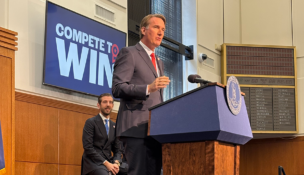Crisis in Baltimore
Bridge collapse diverts ships, cargo to Virginia

The container ship Dali collided with Baltimore’s Francis Scott Key Bridge on March 26, causing the bridge’s collapse. Photo by National Transportation and Safety Board via Associated Press

The container ship Dali collided with Baltimore’s Francis Scott Key Bridge on March 26, causing the bridge’s collapse. Photo by National Transportation and Safety Board via Associated Press
Crisis in Baltimore
Bridge collapse diverts ships, cargo to Virginia
Since the March 26 container ship collision that collapsed the Francis Scott Key Bridge in Baltimore, ships previously bound for the Port of Baltimore have been diverted to other ports, including the Port of Virginia.
The Singapore-flagged container vessel Dali hit the Key Bridge at about 1:30 a.m. March 26 after issuing a mayday following an onboard power outage. The Dali, chartered by Maersk, had previously called at Virginia International Gateway’s terminal and left March 22 for Baltimore, its next scheduled port of call. Six road construction workers were killed in the accident.
Baltimore’s port was closed to ships after the bridge collapsed, with supply chain experts warning it could have a major impact on East Coast trade. In early April, the Port of Baltimore opened temporary shipping lanes to accommodate smaller boats and essential cargo. The U.S. Army Corps of Engineers Baltimore District planned to open a limited access channel for larger vessels by late April and restore full service to the port’s main navigation channel as soon as late May.
According to Rachel Shames, vice president of pricing and procurement for CV International, a Norfolk-based international logistics and transportation company, the collision was expected to create a temporary increase in cargo volume at other East Coast ports, including Norfolk’s terminals.
“It’s likely that nearby East Coast ports, including Norfolk, Philadelphia, New York and others will absorb cargo traffic from Baltimore in the short term,” she wrote. “This sudden increase in volume may strain operations at other ports.”
As National Transportation Safety Board investigators looked into the cause of the crash in late March, the Biden administration pledged federal support to rebuild the bridge, calling on Congress to authorize billions of dollars in funding likely needed for the bridge’s replacement, an undertaking that could take at least a year.
In an interview with Virginia Business, Shames said that the impact of the port’s temporary closing “could end up rippling down to Wilmington, [North Carolina], Charleston, [South Carolina], and Savannah, [Georgia],” although, she noted, “Norfolk is probably the most practical place to absorb most of the capacity. You want to keep the cargo that was supposed to go to Baltimore … as close as possible to Baltimore.”
Apart from the human toll, the port’s closure means a temporary stop to about $15 million a day in daily economic activity for Baltimore, and experts estimated that the ripple effect on railroads, distribution centers and trucking will also cost the city tens of millions of dollars.
Shames also noted that Baltimore’s port is the top U.S. port for the import and export of automobiles, light trucks, wheeled farm vehicles and construction machinery, which often move on specialized vessels.
The Port of Virginia’s Newport News Marine Terminal has facilities that accommodate vehicles, including ramps that allow workers to load and unload rail cars and ships, but not on Baltimore’s scale, Shames said.
“There is capacity at [Newport News Marine Terminal] … but not a lot, nothing like what Baltimore can do. It will not be as simple as just shifting. Unfortunately, I think we are going to be looking at congestion, and I just don’t know how long. That can mean delays for cargo [and] probably extra costs. It’s a ripple, a domino effect.”
As of early April, the Port of Virginia had received about 43% of all redirected container traffic from the Port of Baltimore, more than any other East Coast port, according to supply chain tracker Project44.
However, the increased traffic won’t impact the Port of Virginia’s service levels, Port of Virginia spokesman Joe Harris said. “This is a modern, 21st-century port that has a significant amount of experience in handling surges of import and export cargo.”
n
















